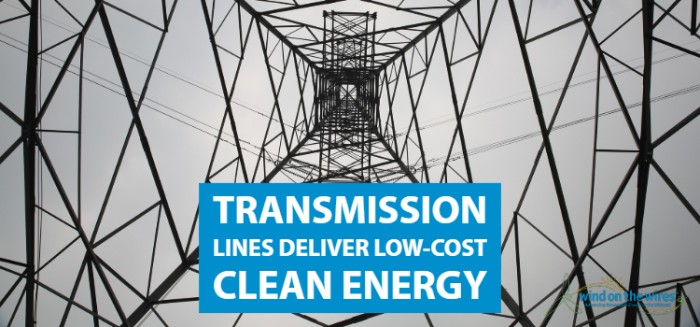Transmission Lines Essential for Reliable, Low-Cost Energy
 | Isak Kvam, Communications / Policy Associate |

 | Isak Kvam, Communications / Policy Associate |
We all take energy for granted. We flick lightswitches, charge smartphones, and work on computers that are tethered, sometimes invisibly, to a reliable power grid. The fact that most people overlook the power grid is a sign that it’s effective – but that effectiveness requires constant maintenance and adaptation. Our grid’s humble beginning in 1870 looks very different from today’s grid – which is the largest, most complex machine in the world. But just as our society has grown more complex and interconnected, so too must the grid – and doing so is a bit like fixing an airplane while flying it.
Transmission lines are the backbone of our electric grid, and they’ve been massively under-appreciated and under-maintained in the past few decades. Planning and investing in transmission infrastructure is crucial to providing reliable, low-cost energy for Americans and our economy.
Transmission lines are the high-voltage highways that transport energy from where it’s generated to where it’s used. Traditionally, they carried energy from a central power plant to a nearby city, serving only a very local region. Today, all of these local regions are interconnected by transmission lines to form the North American electric grid, which draws and transports power across the continent. Transmission lines have improved the reliability of the grid by enabling the pooling of resources together while increasing access to least-cost resources like wind energy, just like highways ease traffic congestion and bolster trade.
Our transmission infrastructure was built decades ago in a different era of power design – and investments are needed to adapt the grid to the 21st century. The American Infrastructure Report Card rated our energy infrastructure at a D+ last year - not quite failing, but poor and at risk. That’s in part because most of the country’s transmission lines are more than 50 years old, and more than 640,000 miles of high-voltage transmission lines across the country are at full capacity. We need to make massive improvements this infrastructure as our power system transitions to become cleaner and more decentralized.
Transmission lines offer a way to cost-effectively deliver this cleaner, decentralized future. Phillip Moeller, the Executive Vice President of the Edison Electric Institute and former FERC Commissioner, summarized it nicely in a Senate Committee on Energy and Natural Resources hearing this February:
“A robust transmission system alleviates costly congestion, provides access to lower-cost generation, increases the reliability and resiliency of electricity delivery, and can flexibly adapt to changes in public policy and sources of electricity generation. This optionality value comes at a surprisingly small cost: on average about 11 percent of the total amount of a customer’s total electricity bill.”
Texas provides a great example of how transmission investments provide better reliability and access to low-cost energy. Texas has an incredible amount of windpower. The state has more installed wind capacity than the next three highest states combined! But these 22,799 megawatts of windpower are all located in the sparsely-populated western region of the state. To deliver this cheap wind energy to the growing population in Eastern Texas, the state designed Competitive Renewable Energy Zones (CREZ) in 2005 to develop transmission lines to improve reliability and deliver low-cost energy in the state. CREZ would accommodate 18.5 GW of wind energy and reduce grid issues like curtailment and congestion.
Today, this $7 billion investment provides a cost savings of $1.7 billion per year for the next 30-50 years – which means it’s saving a lot of money for Texas ratepayers. It’s also good for business and the Texas wind industry, which employs 24,000 people and has invested $42 billion in Texas to date. In fact, Texas has already surpassed the CREZ target of 18 GW of wind and has plans to build 70% more wind. Investments in transmission infrastructure are crucial for continuing to save businesses and ratepayers money by reducing inefficiencies and accessing low-cost wind energy.
Subscribe to our newsletter for the latest on energy & our work
In today’s energy marketplace, low-cost clean energy is powering our future. Utilities are increasingly investing in cleaner energy because their customers demand it, and it is a least-cost source of generating electricity. Additionally, corporations are purchasing renewable energy to power their operations to help their bottom line and reach sustainability goals. The challenge the grid faces will be planning and constructing transmission lines quickly enough; it is currently a multi-year, laborious process. Indeed, stakeholder have suggested streamlining the transmission planning process and studying the true costs and benefits of upgrades.
We know that transmission lines are needed, we know how to build them – but we need to find a way to build them more quickly. The 21st century is a fast-paced world – and our grid needs to adapt quickly to power us forward.
This blog post originally appeared in Morning Consult.
Want to learn more about renewable energy? Sign up for our monthly "Renewable Champions" newsletter to get the latest stories and resources about the Midwest's transition to renewable energy.